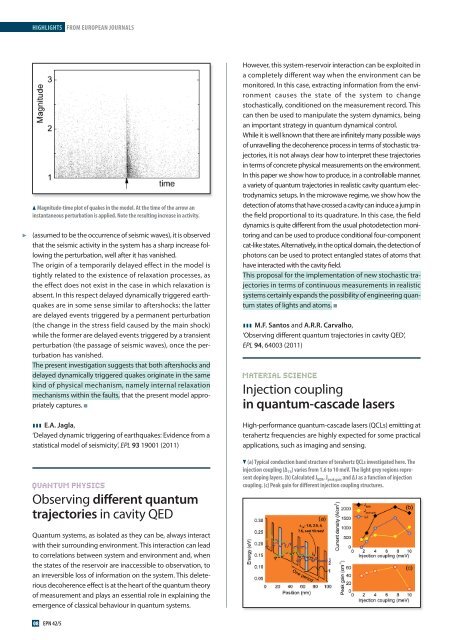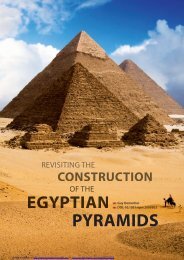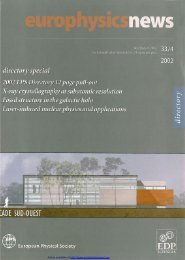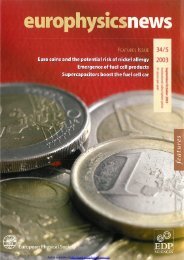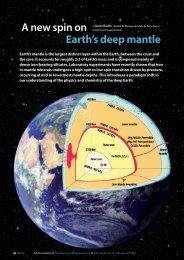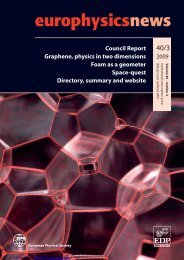PDF (11.37 MB) - Europhysics News
PDF (11.37 MB) - Europhysics News
PDF (11.37 MB) - Europhysics News
You also want an ePaper? Increase the reach of your titles
YUMPU automatically turns print PDFs into web optimized ePapers that Google loves.
�<br />
HigHligHTS from euroPean JournalS<br />
� magnitude-time plot of quakes in the model. at the time of the arrow an<br />
instantaneous perturbation is applied. note the resulting increase in activity.<br />
(assumed to be the occurrence of seismic waves), it is observed<br />
that the seismic activity in the system has a sharp increase following<br />
the perturbation, well after it has vanished.<br />
The origin of a temporarily delayed effect in the model is<br />
tightly related to the existence of relaxation processes, as<br />
the effect does not exist in the case in which relaxation is<br />
absent. In this respect delayed dynamically triggered earthquakes<br />
are in some sense similar to aftershocks: the latter<br />
are delayed events triggered by a permanent perturbation<br />
(the change in the stress field caused by the main shock)<br />
while the former are delayed events triggered by a transient<br />
perturbation (the passage of seismic waves), once the perturbation<br />
has vanished.<br />
The present investigation suggests that both aftershocks and<br />
delayed dynamically triggered quakes originate in the same<br />
kind of physical mechanism, namely internal relaxation<br />
mechanisms within the faults, that the present model appropriately<br />
captures. ■<br />
III e.a. Jagla,<br />
‘Delayed dynamic triggering of earthquakes: Evidence from a<br />
statistical model of seismicity’, EPL 93 19001 (2011)<br />
QUANTUM PHYSICS<br />
Observing different quantum<br />
trajectories in cavity QED<br />
Quantum systems, as isolated as they can be, always interact<br />
with their surrounding environment. This interaction can lead<br />
to correlations between system and environment and, when<br />
the states of the reservoir are inaccessible to observation, to<br />
an irreversible loss of information on the system. This deleterious<br />
decoherence effect is at the heart of the quantum theory<br />
of measurement and plays an essential role in explaining the<br />
emergence of classical behaviour in quantum systems.<br />
08 EPN 42/5<br />
However, this system-reservoir interaction can be exploited in<br />
a completely different way when the environment can be<br />
monitored. In this case, extracting information from the environment<br />
causes the state of the system to change<br />
stochastically, conditioned on the measurement record. This<br />
can then be used to manipulate the system dynamics, being<br />
an important strategy in quantum dynamical control.<br />
While it is well known that there are infinitely many possible ways<br />
of unravelling the decoherence process in terms of stochastic trajectories,<br />
it is not always clear how to interpret these trajectories<br />
in terms of concrete physical measurements on the environment.<br />
In this paper we show how to produce, in a controllable manner,<br />
a variety of quantum trajectories in realistic cavity quantum electrodynamics<br />
setups. In the microwave regime, we show how the<br />
detection of atoms that have crossed a cavity can induce a jump in<br />
the field proportional to its quadrature. In this case, the field<br />
dynamics is quite different from the usual photodetection monitoring<br />
and can be used to produce conditional four-component<br />
cat-like states. Alternatively, in the optical domain, the detection of<br />
photons can be used to protect entangled states of atoms that<br />
have interacted with the cavity field.<br />
This proposal for the implementation of new stochastic trajectories<br />
in terms of continuous measurements in realistic<br />
systems certainly expands the possibility of engineering quantum<br />
states of lights and atoms. ■<br />
III m.f. santos and a.r.r. carvalho,<br />
‘Observing different quantum trajectories in cavity QED‘,<br />
EPL 94, 64003 (2011)<br />
MATERIAL SCIENCE<br />
Injection coupling<br />
in quantum-cascade lasers<br />
High-performance quantum-cascade lasers (QCLs) emitting at<br />
terahertz frequencies are highly expected for some practical<br />
applications, such as imaging and sensing.<br />
� (a) Typical conduction band structure of terahertz QCls investigated here. The<br />
injection coupling (Δ 1’4) varies from 1.6 to 10 mev. The light grey regions represent<br />
doping layers. (b) Calculated J ndr, J peak gain and ΔJ as a function of injection<br />
coupling. (c) Peak gain for different injection coupling structures.


